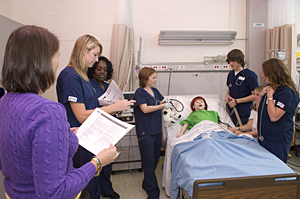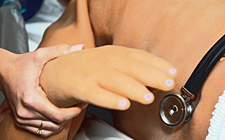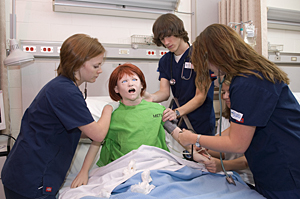

- Rozovsky wins prestigious NSF Early Career Award
- UD students meet alumni, experience 'closing bell' at NYSE
- Newark Police seek assistance in identifying suspects in robbery
- Rivlin says bipartisan budget action, stronger budget rules key to reversing debt
- Stink bugs shouldn't pose problem until late summer
- Gao to honor Placido Domingo in Washington performance
- Adopt-A-Highway project keeps Lewes road clean
- WVUD's Radiothon fundraiser runs April 1-10
- W.D. Snodgrass Symposium to honor Pulitzer winner
- New guide helps cancer patients manage symptoms
- UD in the News, March 25, 2011
- For the Record, March 25, 2011
- Public opinion expert discusses world views of U.S. in Global Agenda series
- Congressional delegation, dean laud Center for Community Research and Service program
- Center for Political Communication sets symposium on politics, entertainment
- Students work to raise funds, awareness of domestic violence
- Equestrian team wins regional championship in Western riding
- Markell, Harker stress importance of agriculture to Delaware's economy
- Carol A. Ammon MBA Case Competition winners announced
- Prof presents blood-clotting studies at Gordon Research Conference
- Sexual Assault Awareness Month events, programs announced
- Stay connected with Sea Grant, CEOE e-newsletter
- A message to UD regarding the tragedy in Japan
- More News >>
- March 31-May 14: REP stages Neil Simon's 'The Good Doctor'
- April 2: Newark plans annual 'wine and dine'
- April 5: Expert perspective on U.S. health care
- April 5: Comedian Ace Guillen to visit Scrounge
- April 6, May 4: School of Nursing sponsors research lecture series
- April 6-May 4: Confucius Institute presents Chinese Film Series on Wednesdays
- April 6: IPCC's Pachauri to discuss sustainable development in DENIN Dialogue Series
- April 7: 'WVUDstock' radiothon concert announced
- April 8: English Language Institute presents 'Arts in Translation'
- April 9: Green and Healthy Living Expo planned at The Bob
- April 9: Center for Political Communication to host Onion editor
- April 10: Alumni Easter Egg-stravaganza planned
- April 11: CDS session to focus on visual assistive technologies
- April 12: T.J. Stiles to speak at UDLA annual dinner
- April 15, 16: Annual UD push lawnmower tune-up scheduled
- April 15, 16: Master Players series presents iMusic 4, China Magpie
- April 15, 16: Delaware Symphony, UD chorus to perform Mahler work
- April 18: Former NFL Coach Bill Cowher featured in UD Speaks
- April 21-24: Sesame Street Live brings Elmo and friends to The Bob
- April 30: Save the date for Ag Day 2011 at UD
- April 30: Symposium to consider 'Frontiers at the Chemistry-Biology Interface'
- April 30-May 1: Relay for Life set at Delaware Field House
- May 4: Delaware Membrane Protein Symposium announced
- May 5: Northwestern University's Leon Keer to deliver Kerr lecture
- May 7: Women's volleyball team to host second annual Spring Fling
- Through May 3: SPPA announces speakers for 10th annual lecture series
- Through May 4: Global Agenda sees U.S. through others' eyes; World Bank president to speak
- Through May 4: 'Research on Race, Ethnicity, Culture' topic of series
- Through May 9: Black American Studies announces lecture series
- Through May 11: 'Challenges in Jewish Culture' lecture series announced
- Through May 11: Area Studies research featured in speaker series
- Through June 5: 'Andy Warhol: Behind the Camera' on view in Old College Gallery
- Through July 15: 'Bodyscapes' on view at Mechanical Hall Gallery
- More What's Happening >>
- UD calendar >>
- Middle States evaluation team on campus April 5
- Phipps named HR Liaison of the Quarter
- Senior wins iPad for participating in assessment study
- April 19: Procurement Services schedules information sessions
- UD Bookstore announces spring break hours
- HealthyU Wellness Program encourages employees to 'Step into Spring'
- April 8-29: Faculty roundtable series considers student engagement
- GRE is changing; learn more at April 15 info session
- April 30: UD Evening with Blue Rocks set for employees
- Morris Library to be open 24/7 during final exams
- More Campus FYI >>
4:27 p.m., Oct. 9, 2008----He breathes, he blinks, he cries and he sweats. He is iStan, a $65,000 mannequin that brings an unprecedented degree of realism to nursing education. As of August, fewer than 250 of the 180-pound models had been shipped to nursing schools and hospitals throughout the country. Thanks to a grant from the Unidel Foundation, the University of Delaware has one of them.
Enabled by software innovations, the development of new high-performance materials and research breakthroughs, iStan has state-of-the-art features not found in earlier generations of patient simulations.
He is wireless and tetherless. He has human-like skin with visible pores and hair follicles, a realistic skeletal structure that enables true-to-life articulated motion, and pulses in 14 locations on the body. His weight gives him the heft of a grown man. And the computer-based scenarios featured with iStan enable students to deal with a broad range of traumas and injuries from stab wounds in the chest to pneumonia with septic shock.
The new mannequin joins a host of others, albeit less realistic ones, in the Clinical Simulation Laboratory at UD's School of Nursing in McDowell Hall.
“The lab allows us to teach cause and effect in a safe environment,” associate professor Judy Herrman says. “Simulations enable our students to gain a tremendous amount of experience by doing procedures and then observing their impact without compromising the health and safety of human patients.”
The simulation suite consists of four labs, each with a focus on a specific set of nursing skills: medical/surgical, health assessment, maternal/child and critical care. The labs are peer taught and overseen by trained nurses.
“The simulations are a great approach, especially for visual learners,” instructor Diane Rudolphi says. “I had one student who commented that the answers on a test came to her much more quickly because of the scenario she had gone through in the lab.”
Another benefit, according to Herrman, is that the students actually get caught up in scenarios from which they might back away if real patients were involved.
“For example, one of our instructors does a scenario where a baby dies,” she says. “If this actually happened in an environment where the students had no previous experience, they would undoubtedly retreat and allow the professionals in the clinical setting to handle it. But with the simulation, they learn how to cope with a devastating experience and gain confidence in their own ability to handle a similar situation in real life.”
The labs allow students to acquire the full range of skills needed for nursing, ranging from drawing blood and hanging an IV bag to delivering babies and preparing toddlers for surgery. Mannequins include Noelle, a woman who gives birth, and newborn Hal, who breathes, cries and is programmed to respond physiologically to students' interventions.
Modern simulations provide today's nursing students with a vastly different experience from that gained by their counterparts two decades ago. Amy Cowperthwaite, a 1987 graduate of UD's nursing program, is now coordinator of the Resource Simulation Center and working on a master's degree part-time.
She recalls that the only lab experience she had before entering the clinical phase of her education was giving herself a subcutaneous injection. “We all had to do it,” she says, “and I remember lying there and trying to talk myself into it. My classmates and I learned everything in the hospital on real patients.”
“Today, we have all of the kits and equipment that would be found in a hospital,” she continues, “and we supervise the students' use of these tools to make sure they can demonstrate competency. By the time they go into the hospital for the clinical experience during their senior year, they've practiced all of the skills, and all that's left is for them to put the pieces together. The students have a lot more confidence in their own abilities, and the instructors are assured of the students' skills because they've observed them. We don't pass the students until they can do it right.”
According to Herrman, simulation technology is growing at an extremely rapid rate, and iStan is just the latest in what will undoubtedly be a continuing trend toward increased realism and capabilities. “It's a whole new way of teaching,” she says. “It doesn't replace clinical time; it adds to it.”
Article by Diane Kukich
Photos by Kathy Atkinson



